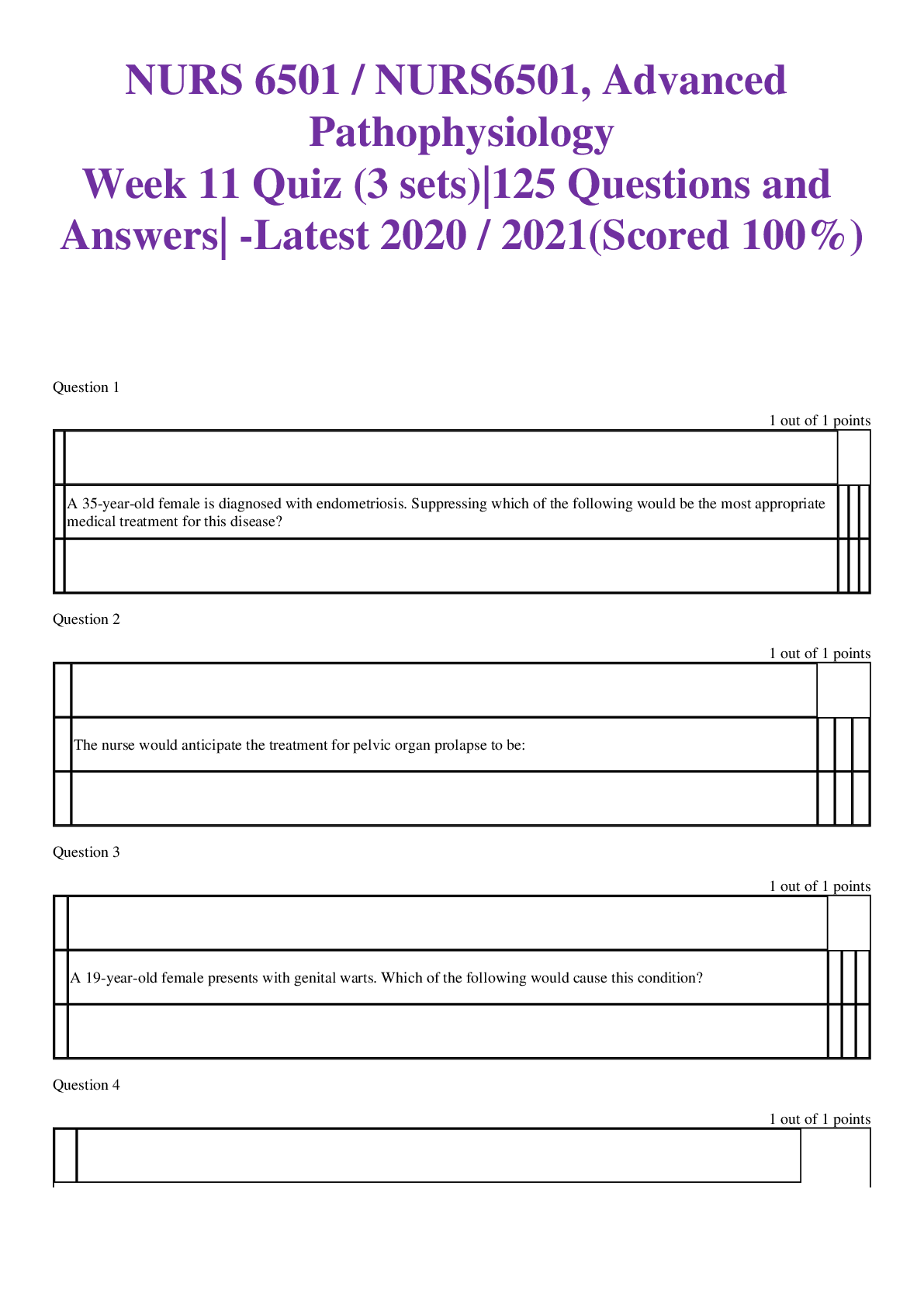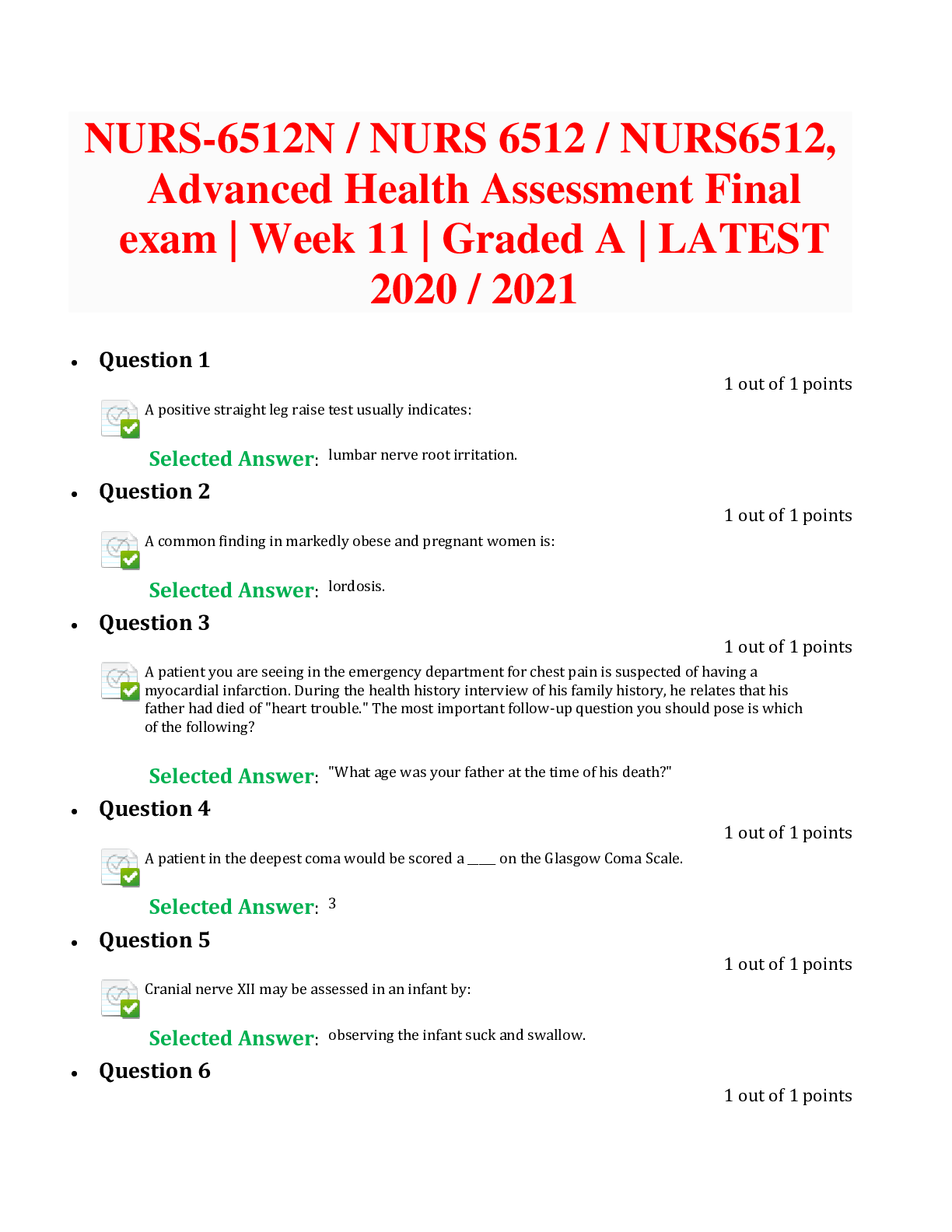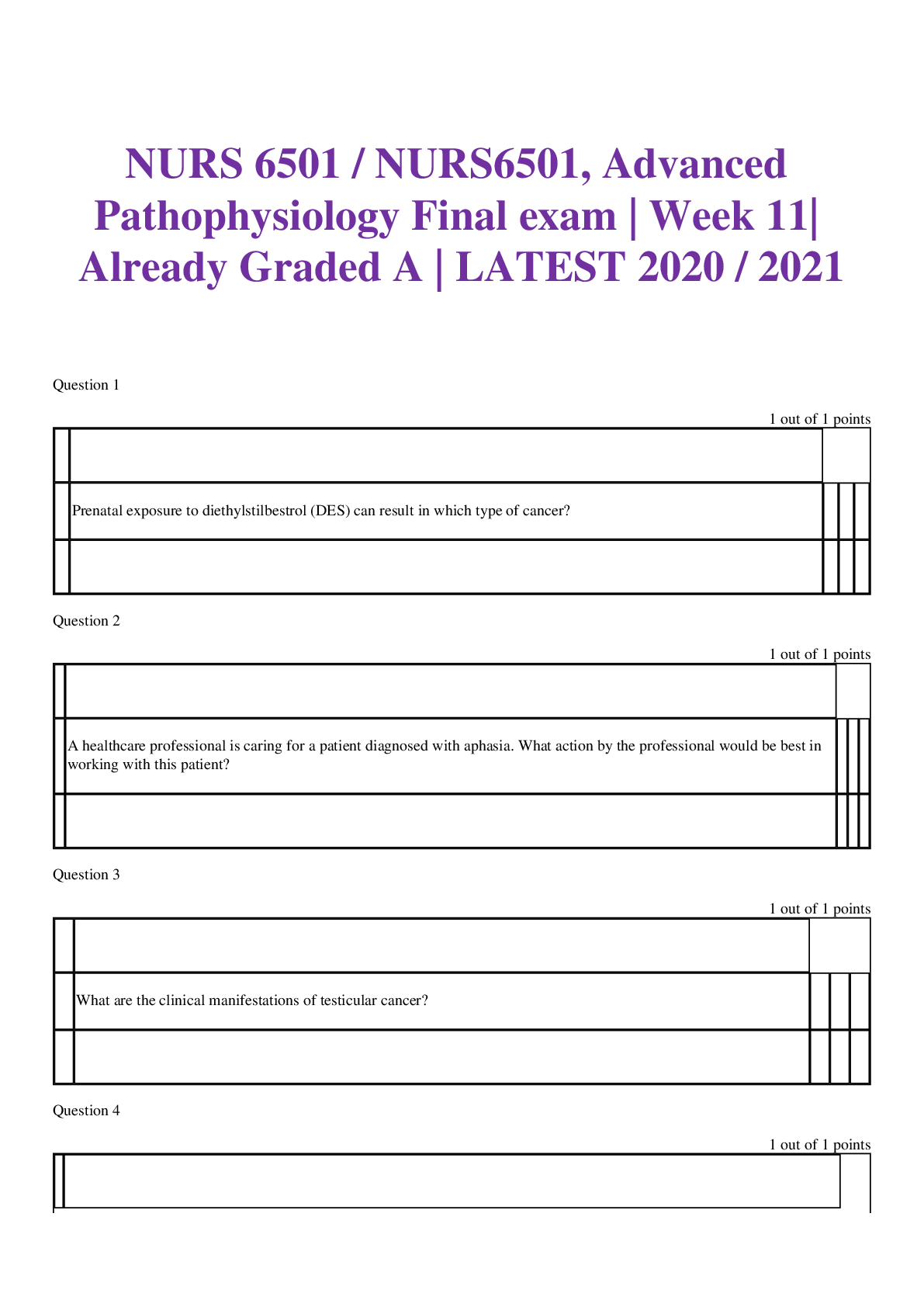NR 443 COMMUNITY ASSESSMENT QUESTIONS | GRADED A
Document Content and Description Below
1. Which of the following would be the best way to determine the health of a community? a. Ask a firefighter which neighborhoods have the fewest fires. b. Ask a realtor which neighborhoods have the ... most expensive houses. c. Ask people living in the neighborhood if they are happy with where they live. d. Ask the police department which neighborhoods have the lowest crime rates. A healthy community is one in which residents are happy with their choice of location and exhibit characteristics that would draw others to the location. Thus, the best way to determine the health of the community is to talk to those living in it. 2. Which of the following characteristics would be most indicative of a healthy community? a. Excellent private schools and superb fire and police systems b. A United Way that receives large donations each year c. An extensive array of services offered by private physicians d. Clean air and water and a sense of community cohesion Although all items sound positive, a sense of community cohesion in a safe community (clean air and water) would be most helpful to its residents. 3. A nurse was assessing the neighborhood near the health agency. The nurse drove around observing the condition of the buildings, sidewalks, and the people in the community. Which of the following best describes the actions of the nurse? a. A drive-through b. A neighborhood observation c. A quick overview d. A windshield survey A walk- or drive-through is frequently referred to as a windshield survey. This is one way that the nurse can get a feel for the community that cannot be obtained from just reading about it. 4. Which of the following would be the best definition of a community? a. People with open boundaries living in a particular area b. People gathered together to solve a particular problem c. People with a sense of belonging or common identity d. People with at least one common demographic characteristic In this text, community is defined as an open social system that is characterized by people in a place who have common goals over time. The sense of belonging or common identity is true both of geopolitical and of phenomenologic communities. A population is defined as a collection of individuals who share common characteristics. 5. Which of the following is an essential characteristic of a community? a. A geographic area with defined boundaries b. A particular place over time for common purposes c. A place and beliefs or value systems d. A place or common demographic characteristics The three common factors that constitute a community are people, place, and social interaction or common goals. 6. Which of the following is an example of a phenomenologic community? a. The employees of Delco Manufacturing b. The Miami Valley region c. The village of Yellow Springs d. The United States Census Bureau census tract #1017 All of the options are examples of geopolitical communities except the staff of a company, which is a phenomenologic community or a community based on relationships, not geopolitical boundaries. 7. Which of the following best describes a group? a. Those who are all living in the same geopolitical area b. Those who are all members of the same phenomenologic community c. Those who engage in repeated face-to-face communication d. Those who respect each other’s perspective A group consists of two or more people engaged in an interdependent relationship that includes repeated face-to-face communication. 8. When community/public health personnel speak of a community of solution, to what are they referring? a. A community that has resolved its major problems at least temporarily b. The area in which some problems are approached on a wider regional basis c. The fact that communities have to solve their own problems d. The reality that some problems have to be approached on a federal basis A community of solution refers to the boundaries within which a problem can be identified, addressed, and solved. Such problems are often beyond one communities’ boundary but affect several communities, which must work together to resolve the problem. 9. When a community is assessed from a developmental framework, which data must be determined? a. The demographics (such as age) of the persons living in the community b. The emotional maturity of the community’s residents c. The history of the community d. The number and quality of daycare centers and schools Although all the listed options may be helpful information, the development of a community would most easily be observed in its history. A developmental framework explores the history of a community to determine change and trends. Identifying trends in health status over time helps clarify health outcomes. 10. Which of the following would be the focus of a nurse who is using an epidemiologic framework to assess a community? a. Interviewing health care professionals concerning the community b. Researching findings from epidemiologic studies c. Learning about the health of the communities population d. Discovering groups among the community residents who are most at risk In an epidemiologic framework, investigators examine the health of the community and suggest targeting programs toward the groups most at risk for illness or disability. Different aggregates have different health needs. 11. Which of the following situations is a reason why a community/public health nurse would choose to focus on a particular subgroup instead of on the entire community? a. The subgroup can more easily afford health care services. b. The subgroup has more political power and can influence health funding. c. The subgroup has notably higher statistical risk for experiencing health problems. d. The subgroup knows how to obtain publicity if their needs are not met. Although all of the option’s present good reasons, the community/public health nurse tries to change factors that contribute to the vulnerability to health problems of high-risk groups. 12. When assessing a community by using the structural-functional framework, the nurse recognizes that all communities must a. Address financial needs of residents. b. Engage in functions that can be measured. c. Provide for socialization and a sense of identity. d. Require that public safety structures be built. All communities fulfill certain functions, including coordination, control, and direction of activities to attain goals, as well as socialization and identity for their members. Providing for both socialization and a sense of identity best address community goals and internal functioning. 13. A nurse is completing a community assessment by using a systems framework. Which of the following is the key to the success of the assessment? a. Demanding a reasonable budget for assessment expenses b. Telling everyone what he or she is doing so that the listener may have input c. Using a tool to systematically identify, collect, and organize appropriate data d. Allowing at least 2 weeks to collect data to ensure thoroughness An organized framework helps the nurse collect appropriate data systematically. The systems model serves as a tool to help the nurse identify, collect, and organize appropriate data, include the critical components and their relationship to each other. 14. What is the first step in beginning a community assessment? a. Choosing persons who live in the community and may share their insights b. Creating a budget of both time and money to devote to assessment c. Defining the community and determining its boundaries or parameters d. Outlining the data needed and determining where they might be found Before a community can be assessed, the exact community must be clearly delineated; the nurse accomplishes this by defining the community and determining its boundaries or parameters. This will determine what data the nurse will need to collect. 15. Why would a nurse be concerned when a community has relatively closed, rigid boundaries? a. The community does not have an identity. b. The community is probably resistant to change. c. The nurse will not be able to share community resources. d. The nurse may have limited access to the community. A closed, rigid system is resistant to change, whereas an open, more flexible system is more receptive to change and to help from the health care delivery system. 16. Which of the following events illustrates how the suprasystem affects a community as a system? a. A group of concerned citizens points out the rising number of homeless persons in the community. b. A subgroup of the community demands that housing for homeless persons be built. c. Homeless persons decide to picket in front of the city government building. d. The state legislature passes a law that all communities must build some housing for homeless persons. Only if the state dictates a legal requirement to a local community is it an instance of the suprasystems directly affecting the (community) system. 17. How might the goals of communities best be summarized? a. Ensuring that the communities history is remembered b. Encouraging socialization with persons outside the community c. Maximizing availability of financial and other resources d. Promoting survival and maximizing the well-being of members Communities must survive and ensure that the needs of community members are met, including the need for well-being. 18. Which demographic factors of a community are important for the nurse to consider when assessing a community? a. Census tract data can be used to determine needed agency staffing. b. Density of housing is associated with contagious infections. c. Ethnicity determines how health is defined and protected. d. Income determines what community services can be financed. Although demographic factors (age, race, gender, ethnicity, and density of population) are important for many reasons, the focus of assessment is on promoting and maintaining health. Therefore, health as the community defines it must be understood. Ethnicity determines how the community addresses health problems and attempts to protect the health of its members. 19. Which of the following is an example of the relationship between demographic factors and health needs? a. Persons with high incomes typically have nutritional problems resulting from diet choices. b. Low educational level is associated with more health promotion behaviors. c. Religion may suggest beliefs concerning use of contraception, health care, and food choices. d. Being the majority population group, young adult men help determine which service agencies are most needed. The religion of the community members may suggest their beliefs about contraception, abortion, living will, circumcisions, organ donations, and so on. 20. What might be the implications of knowing where members of the community are employed (i.e., their occupations)? a. How or whether community members worship b. How and when the community members prefer to engage in recreation c. The diseases or injuries for which they may be at risk d. Where residents do their grocery shopping and what they typically buy Knowing the occupations may suggest particular diseases and injuries for which employees are at risk. 21. When a nurse assesses a community, which of the following components is essential to determine first? a. Areas of strength b. Areas of need c. Balance of inputs to outputs d. Openness to intervention When assessing, whether individuals or systems, it is essential to determine areas of strength, as well as areas of need. Several chapters in the text emphasize that strengths should be assessed first because strengths are the tools used to address weaknesses. 22. A community/public health nurse is planning to implement a new community-based education program. Why is it crucial for the nurse to understand the organizational structure of a community, as well as its leadership? a. The nurse may have to convince the informal leaders of the need for the program before it can be successful. b. The nurse may need to ask the formal leaders to provide leadership for the programs. c. The nurse will want to know political priorities before deciding on any actions to be taken. d. The nurse will want the approval of the elected governing body before making decisions about health programming. It is important for the nurse to identify both formal and informal leaders. Informal leaders often have the social power, even though the formal leaders have the authority in decision making. To be successful in any kind of change, the nurse needs a thorough understanding of both the formal and informal leadership dynamics. 23. Which group of persons is least likely to be considered a vulnerable group at high risk for medical problems? a. Homeless women and children b. Intravenous drug users c. Pregnant single teenage girls d. Single adolescent boys In examining person-related factors, the nurse looks particularly for vulnerable aggregates and risky behavior. Homeless persons, intravenous drug users, and pregnant single teenage girls are all at high risk for medical problems. As a group, single adolescent boys do not have a condition that makes them vulnerable to illness. 24. A community/public health nurse determines there are 200 persons in a particular community who are older than age 65, another 300 younger than 21, and about 1500 persons aged 21 to 65. What is that communities dependency ratio? a. 1:3 b. 1:8.5 c. 1:9 d. Cannot be determined from the given data If 500 persons are younger than 21 or older than 65 and 1500 persons are aged 21 to 65, the dependency ratio is 1:3. That is, in terms of aggregates, there is 1 dependent person for every 3 who are probably able to care for themselves. 25. Which of the following is a very practical and feasible way of obtaining comprehensive community health data? a. Completing a comprehensive survey with community residents b. Performing a windshield survey c. Requesting community residents respond to an Internet survey d. Using data already collected and available on the Internet Many sources of demographic and epidemiologic data already collected, and often available on the Internet, may be used. It is not feasible or financially possible for the nurse to do a comprehensive community assessment in isolation. Performing a windshield survey does not allow the nurse to collect comprehensive health data about the community. Requesting community residents respond to an Internet survey can be a very time-consuming process for the nurse to undertake, especially when there are already data collected and available. 26. What is the primary reason why entire populations are not surveyed to determine a communities health needs? a. A nurse would not know how to conduct the survey. b. Community members would refuse to answer questions. c. Such a survey would be too expensive and time consuming. d. No community agency would want to be responsible for the results. Although a survey of an entire population would be informative, it is typically too impractical in time, cost, and ability to reach all community members. 27. A community/public health nurse wants to use key informants to gather additional information. Which of the following actions would be useful to perform first? a. Sending an e-mail message to all community residents b. Conducting a focus group with informal leaders from the community c. Publishing a survey in the local newspaper d. Requesting that childrens parents complete a survey Although any of these options might be useful, a focus group with the communities leaders would probably yield the most reliable data. Further meetings or focus groups might then concentrate on special at-risk groups. 28. The nurse is using previously collected data about the incidence and prevalence of lead poisoning in the community as a starting point when conducting a community assessment. What would be the nurses next step? a. Assessing the community in relation to lead poisoning b. Determining how best to help other personnel decrease the incidence of lead poisoning c. Gathering external resources to help meet the needs of the community d. Working with collaborating agencies to obtain external funding to prevent lead poisoning One approach to community assessment is the problem-oriented approach. Using this approach, the nurse assesses a community in relation to a specific topic or health problem. The nurse begins the process with the problem or topic area and then assesses a specific community in relation to that topic. If a particular problem has been identified in previously collected data, the nurse should assess the community in relation to the identified need before gathering resources, working with others, or trying to help colleagues, who may have other priorities. 29. Which of the following conclusions would require the nurse to obtain more assessment data? a. A major health problem is identified. b. An identified subpopulation is seen to be at high risk for and vulnerable to medical problems. c. Data that have been collected are incongruent and contradictory. d. Strengths in the community outweigh the areas of weakness. The data must be congruent, or data explaining the discrepancies must be found, before inferences about the level of community health can be made. 1. Which of the following are included in the subsystems of Anderson and McFarlanes definition of a community? (Select all that apply.) a. Communication and health/social services b. Demographics and census data c. Economics and recreation d. Physical environment and education e. Politics and government f. Safety and transportation The eight subsystems are communication, health and social services, economics, recreation, physical environment, education, politics and government, and safety and transportation. Demographics and census data are not subsystems. 2. Which of the following are framework models currently in use in community health nursing? (Select all that apply.) a. American Nursing Community Health Model (ANCHM) b. Community-as-Partner model c. Mobilization for Action through Planning and Partnerships (MAPP) d. Helvie Energy Framework e. General Ethnographic and Nursing Evaluation Studies in the State (GENESIS) f. The geopolitical phenomenological model There is no such model as ANCHM. Geopolitical and phenomenological models are two ways of addressing a community. Community-as-Partner, MAPP, Helvie Energy Framework, and GENESIS are all framework models currently in use in community health nursing. [Show More]
Last updated: 1 year ago
Preview 1 out of 8 pages

Buy this document to get the full access instantly
Instant Download Access after purchase
Add to cartInstant download
We Accept:

Reviews( 0 )
$12.00
Document information
Connected school, study & course
About the document
Uploaded On
Feb 07, 2021
Number of pages
8
Written in
Additional information
This document has been written for:
Uploaded
Feb 07, 2021
Downloads
0
Views
30

























